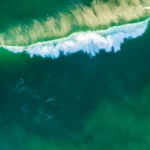De Beers Group, a pioneer in the Diamond industry has been harvesting stones from under the Atlantic Ocean.
De Beers spent decades building a global empire (some would call it a “cartel”) around diamond mines in countries like South Africa.
So why did they purchase more than 3,000 square miles, or 7,770 square kilometers, of Atlantic seafloor near the coast of Namibia in 1991?
Simple: Not all diamonds are found on dry land. Many turn up in sediments below the ocean’s surface. You just have to know where to look.
Time and Pressure
Carbon is a wonderfully versatile element found in Earth’s atmosphere and all living things (that we know of). It’s also well-represented in jewelry stores.
Diamonds are made of carbon atoms that’ve been subjected to extremely high temperatures and pressures. The crystals usually have eight sides, but six- and twelve-sided specimens are out there, too.
Inside a diamond, every individual carbon atom shares a strong bond with four others, which makes diamonds ridiculously hard. Rub one of these gems against almost any other known mineral and it’ll leave a scratch mark behind.
Asteroids can create the intense heat and pressure needed to produce diamonds when they strike the face of our planet. Such “impact diamonds” are pretty rare, though. And they tend to be small.
You’re way more likely to find a diamond from deep within the Earth, forged somewhere in the ballpark of 87 and 497 miles (140 to 800 kilometers) under the surface. And the ocean may have played an underappreciated role in the history of our world’s diamond supply, as well.
Ocean Origins?
Many diamonds contain small quantities of salt. For years, geologists wondered if this originally came from seawater.
A 2019 study bolstered the hypothesis. It turns out that when a blend of marine sediments and the volcanic rock peridotite experience high heat and tremendous pressure in a laboratory setting, you get something that looks an awful lot like the salts trapped inside some diamonds.
What’s this mean for the real world? According to the paper’s authors, their experiment suggests most diamonds come into being after chunks of seafloor are dragged into Earth’s mantle via plate tectonics.
Some of the minerals taken from the ocean during this process crystallize into gems. Volcanic eruptions later bring the diamonds up to the planet’s surface — or pretty close to it.
Carried Away
Now, the study mentioned above doesn’t explain why De Beers and other groups are hunting for diamonds off the African coast.
Those stones were carried out to sea by river currents. Namibia’s southern border is defined by the mighty Orange River. For millions of years, it’s been grabbing ahold of diamonds from mainland deposits and relocating them elsewhere on the continent.
Only sometimes, this river ferries the precious jewels all the way out to the ocean.
Since the 1960s, treasure seekers have been dredging up diamonds by the coastlines of northwestern South Africa and southern Namibia. In 2018, nearly 75 percent of the latter country’s total diamond output came from ocean-based mining operations.
De Beers emerged as an industry leader (go figure) back in the 1970s. “We operate a fleet of six motor vessels (mv) capable of exploring for and retrieving diamond-bearing materials from the seabed and processing them to a diamond-rich concentrate,” reports the company’s website.
Under the Sea
Most of these gems are harvested at depths of 394 to 460 feet (120 to 140 meters) below sea level.
Sediments from the ocean floor are sucked up into a remote-controlled “crawler” vehicle that scuttles across the seabed. Fitted with a mechanical arm, it sends diamond-laden payloads to the main vessel up above, where machines separate out the jewels.
Drones and two person submarines have both been used to help these ships find diamond-rich localities beneath the waves.
Unfortunately, dredging campaigns can have long-term consequences for aquatic wildlife.
As ecologist Kirsten Thompson told CNN in 2018, “[the] waters off coast of Namibia are an important area for a high diversity of resident and migratory species, such as sharks, whales, dolphins and seals…. Marine mining removes parts of the seabed with heavy machinery and habitat recovery from this type of disturbance can take decades.”
Gathering these “ocean diamonds” by hand, with hired divers in small boats, is another option that’s been executed in recent years.









